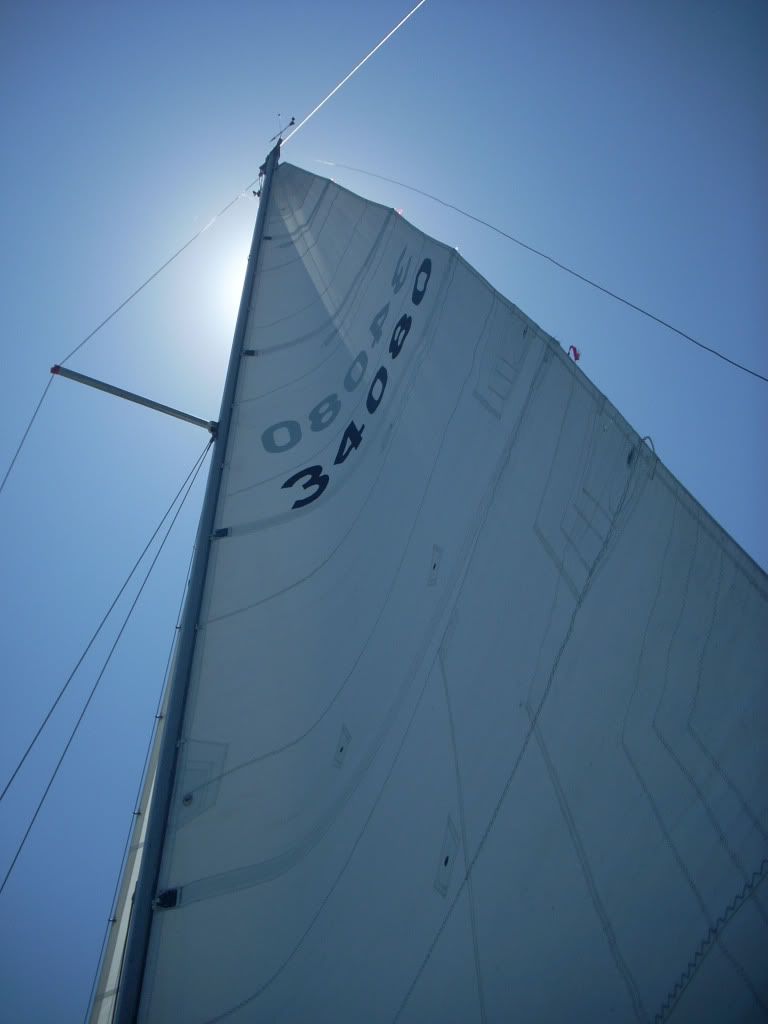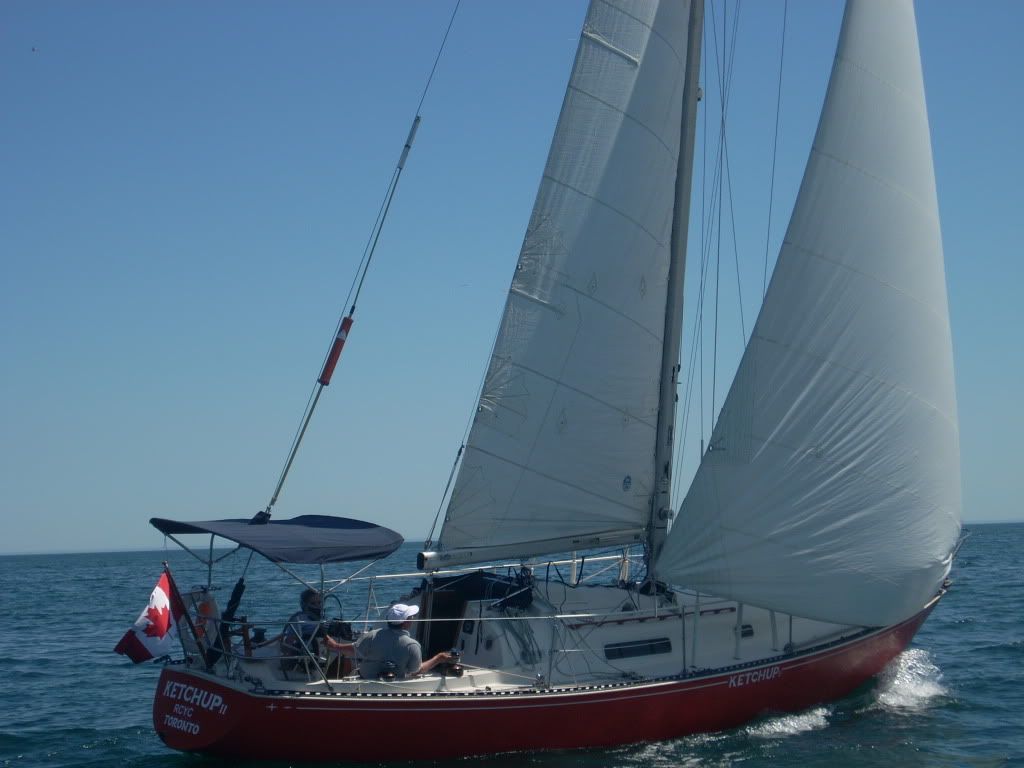
Nice, isn't it? This is the lightly used main from a C&C 33 recut for use on the Viking 33, the elder boat in my half-landbound "navy". Really, it should have full and not half-battens, but we'll start slowly this year, shall we? Really...I should be working on the other boat, not sailing at all, but it was so nice yesterday!
We got the plastic boat underway yesterday in somewhat marginal light air that actually improved even as the temperature rose past 30C. For a first push-off of the season with the wife and kid, it was blessedly free of complications, skipper foul-ups and error, and we got in about four hours of decent sailing on a gratifyingly beautiful Sunday afternoon.
I've written about the old boat before, but to reiterate, it's called a Viking 33, a 33' 7" "racer-cruiser" drawn in the very late '60s by the C&C firm of yacht designers and builders. Bearing the distinctive (at least on the Great Lakes) C&C "star and stripe" cove line, the Viking 33 was built by Ontario Yachts (responsible for the Ontario 32 pocket cruiser and a few other well-regarded boats) for about eight years. Mine (Valiente) is hull #32 of approximately 150 constructed, and was built in 1973. I know of about five or six still sailing in my immediate area, including one, Sveeta, a 1974 model at my home club, and Ketchup, another 1974 at RCYC.

The owner of Ketchup is Mr. Dan Erlich, a fine fellow I got to know via an e-mail list about 10 years ago on the subject of care and feeding of the Atomic 4 gasoline auxiliary engine, a simple and reliable beast that, despite its more or less 1940s design, is the right size and type for short-haul movement of recreational sailboats.
Today, small sailboats tend to have either outboards off the stern (not great looking, too much weight aft and too exposed for my liking), or small diesels inboard (heavy, expensive and not suited to short operational intervals). A low-compression, gasoline inboard no more complex than a riding lawnmower engine makes sense for a sailboat that isn't going to need hundreds of miles of range, but engines like the Atomic 4, once the Number One auxiliary engine choice in sailboats under 40 feet, has fallen to the mighty, and mightily inappropriate for most sailors' needs, auxiliary diesel, which I find a pity, as to re-engine our classic plastics with diesels in 2010 makes no economic sense; a pair of sculling oars would be the more logical course, or perhaps putting a shaft on a sole-bolted exercise bike.
Needless to say, any engine that sits idle for six months of the year and which ceased production a quarter-century ago requires some sort of support system, and Dan is pretty clever at both obtaining increasingly rare spares and making them come to life again. Despite having near-identical boats (although I've opted for "stripped out" and Dan's got a comfort- and cruising-oriented family and hot-and-cold-running everything), we've never...until yesterday...run our respective darlings side-by-side. Dan was out yesterday with his mother for a nice cooling ride and so we "gammed" and ran parallel for about four miles to the west-south-west, "in front of the Island" as we say in Toronto.

What a great trip. We had near-identical sail sets and it was very interesting to see how closely the boats performed in "level" conditions. It was also a little odd to see what one's boat looked like from a distance! I rarely meet another Viking 33 actually sailing, and having both boats tracking within a boatlength on the beam was a great opportunity to check out variables, that while only of interest to the owners, were fun to observe.
The cheerful second helmsboy was also fun to observe:

Also, quite frankly, they are "hot", responsive boats, and I like tweaking the controls to get that extra 1/10th knot in close quarters...it's about as near as I get to racing these days.





2 comments:
Hi, I'm Danny. You made a post in a forum thread I started. I bought a severely neglected 1973 Viking 33 a couple of years ago. I replaced all the important stuff. Sails, Standing rigging, a moyer exchange A4 engine, yadda yadda yadda. I've gotten a world of Advice from Dan Erlich myself! What a great guy!
What is that bow fitting you have on your boat? I would love a nice roller up there. I intend to install a windlass this off season.
Hi, Danny, and welcome to the Viking 33 club. If you bought the '73 Viking I saw in '99 in Rochester, NY, it was indeed in rough shape and featured a poorly repaired T-bone amidships. Hope there's nothing you can't repair with yours.
Dan E. is indeed a great resource on this model of boat. He's gone way beyond hobby!
The bow fitting is a custom-made piece salvaged from a C&C 35. I had a guy fab and weld in a plate that would mate with the Viking stem fitting, and mine is backed with a simple piece of track as a backing plate. It's short and strong and works well. It's also saved me from dinging the bow in heavy air dockings.
If you install a windlass (and I don't think it's needed on a boat that has as light ground tackle as the Viking, you would naturally consider some other refinements, like an anchor locker lid and replacing the cored deck with solid and extensive fibreglassing, plus backing plates. There's also the issue of the Atomic 4 providing enough juice to keep the batteries happy if you have to run a 1000 w windlass...manual is better here, I think.
Then you'd need a proper chain fall. Too much work for me, but if you sail in tidal or windy areas, it's not a bad idea.
To my mind, it's easier to hand-over-hand it and just throw the cleaned rode and chain into a food-grade five-gallon bucket. I have a "heavy" ground tackle that I use past 15 knots or so. I detail it here:
http://alchemy2009.blogspot.ca/2011/08/on-rode-again.html
A Fortress even with chain is light enough to do the job if you decide against a windlass.
As for the rest, if your chain plates and knees are in good shape (no crevice corrosion or evidence of cracking), tune that new standing rigging with a Loos gauge and go throw the boat around. You'll be amazed at how a tight (not over tight!) rig can improve performance. I replaced the standing rigging this last winter, and we set a new SOG of 9.0 knots just last weekend.
Thanks for the post.
Post a Comment